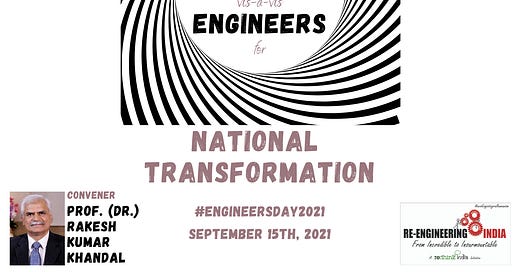Not Nehru, but M. Visvesvaraya was the choice of Subhas Bose as the Chairperson of the National Planning Committee in 1938
Inviting One and All to the Roundtable on Economists Vis-a-Vis Engineers for National Transformation Commemorating Engineers' Day, 15th of September 2021 from 3 pm onwards...
Roundtable on Economists Vis-a-Vis Engineers for National Transformation
Commemorating Engineers' Day, 15th of September 2021 from 3 pm onwards...
LIVE on https://bit.ly/rethinkindiayoutube.
For ZOOM Link, Do Ping, Dr. Surbhi at 9910050597
The engineer-Statesman, Shri Visvesaraya (15 September 1860 - 14 April 1962), who departed at the ripe age of 101 Years, an alumnus of the College of Engineering, Pune was the first to advocate the idea of planning for India.
Visvesvaraya was a legend, a part of the folklore of Karnataka, a great engineer known for his immaculate dress sense and honesty. For Visvesvaraya, character-building, dam-building and nation-building were equivalent activities. The emphasis was on planning and discipline, an emphasis that extended to his private life. Visvesvaraya was immaculate in differentiating between the public and the private.
Legend has it that he always carried two fountain pens, one for official use and the other for personal use. When one reads his memoirs, one feels it reads like a policy document. The eccentric and the innovative combined brilliantly in this life. Visvesvaraya’s ideas of planning also included the first ideas of car manufacture. He was closer to business and this stream of ideas culminates in the Bombay Plan, a business model of planning.
In his famous book, “The Planned Economy For India”, published in 1934, he proposed a ten-years’ plan with the aim of doubling the income of the country. His main emphasis was on industrialization so as to reduce the population dependent on agriculture and to increase the population employed in the industry.
However, Sri Visvesvaraya’s plan was more on the lines followed in the U.S.A. and Turkey; its basic policy was to avoid ‘communistic tendencies’ and to encourage collective effort without interfering with individual initiative. In short, his plan was drawn within the framework of a capitalist economy.
In 1938, on the behest of Meghnad Saha the then President of the Indian National Congress got the 15 Member National Planning Committee established. The Congress meeting was held in Delhi in 1938. Saha attended it a day late and in the meanwhile, M. Visvesvaraya had been elected head of the Planning Committee. Meghnad Saha approached the great engineer and requested him to step down. He argued that planning needed reciprocity between science and politics. Visvesvaraya generously agreed and Jawaharlal Nehru was made head of the National Planning Committee.




